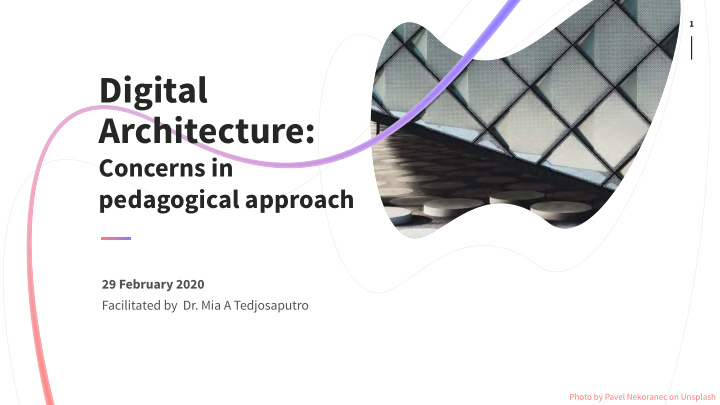



1 Digital Architecture: Concerns in pedagogical approach Photo by Pavel Nekoranec on Unsplash
Digital Architecture? Photo by Michael Busch on Unsplash
3 Outline 1 2 INTRODUCTION DIGITAL Aims TURNS LOs Assessment
4 3 4 ACTIVITY: QUIZ AND JIGSAW PEER READING EVALUATION 3 GROUPS
5 Aims and objectives
6 01 Learning outcomes Students will be able to.. 02 03
7 Formative LO-01 Digital turns assessment: 4 LO-02 PEER EVALUATION LO-03 In forms of quiz and peer evaluation
8 Carpo, M. 2011. The alphabet and the algorithm, MIT Press. Carpo, M. 2017. The Second Digital Turn: Design Beyond Intelligence, MIT Press.
9 First digital turn • Circa 1990, renowned architects embraced digital change . • From identical copies to customised or non-standardised products. • First generation of digital design and fabrication. • Digital fabrication does not use mechanical matrices, casts, stamps or moulds. • Making digital copies will not reduce the cost. Photo by Claudia Lorusso on Unsplash
10 Second digital turn • Separation of the ways architects think, draw and make dissipated. • Non-humanistic way: computers can work faster. • New taxonomy of digital architecture. • Oxman (2008): digital architecture as a challenge in design pedagogy . Oxman, Rivka (2008). Digital architecture as a challenge for design pedagogy: theory, • Oxman and Oxman (2014), an edited knowledge, models and medium. Design Studies, 29, 99-120. book: theoretical foundations of this Oxman, Rivka and Oxman, Robert (2014). Theories of the digital in architecture / new architecture. [edited by] Rivka Oxman and Robert Oxman, Routledge, Taylor & Francis Group. Photo by Evgeniy Sholokh on Unsplash
11
12 Peer-reviewed conference paper
13 Research methodology: Six design education practices
14 Jigsaw reading Group allocation STEP 1 Read input texts individually STEP 2 Summarise text to group members STEP 3 Short quiz (see guiding Qs) STEP 4 Evaluate each others’ performance STEP 5
15 Concerns are classified into three categories Digital Digital Digital 01 02 03 design design design cognition eco- pedagogy system
16 QUIZ Guiding questions What was the main point? What was most interesting detail? Was there anything in the reading that you disagree with? Why?
17 17 Peer evaluation SCAN THE CODE OR GET THE LINK AS BELOW http://www.123formbuilder.com/form-5316174/form
18 Re-thinking architectural pedagogy Knowing when and why digital mass customisation is needed. Celebrating craftmanship . Re-learning from the “local wisdom”. Architects in the middle during of the act of: notating, representing and fabricating. Utilising technological advances to full potential.
19 Re-iterated aims and objectives
20 Homework Further reading “How has your understanding of digital architecture changed?” Online forum discussion. Will be reviewed before the start https://miatedjosaputro.com/2020/02/28/pgche- of next class. edu710-assignment-1-practice-class-materials/
21 Further reading Organisation with regular conferences ACADIA: http://acadia.org/ CAADRIA
22
23 Digital design 01 cognition • The shift is the relational value between designers and design tools. • Proposing the use of embodied cognition* lens in design studies. • Mind-body-design environment. • “What is the dialogue between designers and (digital) design tools in the design ideation process?” • Design tool affordances. * Tedjosaputro, M. A. & Shih, Y.-T. (2019). Perceiving Design Processes as Embodied Experience. Research into Design for a Connected World. Springer.
24 Digital design 02 eco-system • Digital tools do not work in isolation . • The eco-system hosts a variety of design software in application. • Dynamic ecosystem is proposed by case study #7. • Selection of tools entails strength and weaknesses of designers and tools (#6) • Interoperability challenges (#5). • Design fixation challenges.
25 Digital design 03 pedagogy • Specialist software requires specialist knowledge. • Potential problems : design fixation and lack of understanding of design tool affordances. • New design skills are shaped. • Scripting in architecture pedagogy? • Suggestions: subtle transitions between analogue and digital design pedagogy.
26 Conclusions and take-away 01 02 Design behaviour has From CAD (Computer Aided shifted due to the change of Design) to computational relational value between design, as a new discourse. designers and digital design tools. Photo by Aideal Hwa on Unsplash
Recommend
More recommend